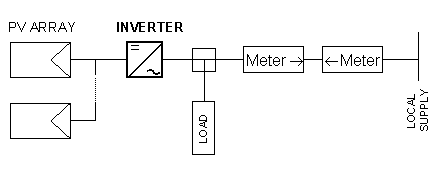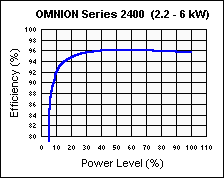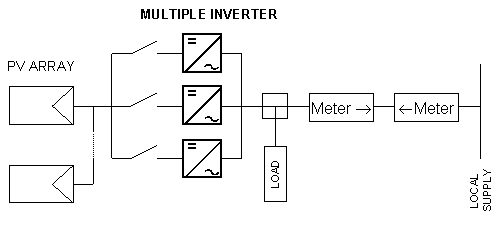








 |
| Design options | Conclusions |
The basic Grid Connected PV system design has the following components:

Fig. 1.Single inverter Grid Connected System.
- PV ARRAY or Generator. A number of PV panels connected in series and/or in parallel giving
a DC output out of the incident irradiance. Orientation and tilt of these panels are important design parameters,
as well as shading from surrounding obstructions.
- INVERTER. A power converter that 'inverts' the DC power from the panels into AC power.
The characteristics of the output signal should match the voltage, frequency and power
quality limits in the supply network.
- LOAD. Stands for the network connected appliances in the building that are fed from the inverter, or,
alternatively, from the grid.
- METERS. They account for the energy being drawn from or fed into then local supply
network.
- LOCAL SUPPLY NETWORK. A single or three-phase network managed by a Public Electricity Supplier. The supply network acts both as a sink for energy surplus in the building or as a backup for low local generation periods.
The overall efficiency of the system depends on the efficiency of the SUNLIGHT-into-DC and the DC-into-AC conversion efficiencies. The first one varies up to 3% over a year. The second one, instead, shows a much greater variability.
The efficiency of the inverter varies with the load level. Although this relation is different for each inverter, a conventional model has a load/efficiency curve similar to Fig. 2. Therefore, a key consideration in the design and operation of inverters is how to achieve high efficiency with varying power output.

It is necessary to maintain the inverter at or near full load in order to operate in the high-efficiency region. However, this is not possible. Some installations would never reach their rated power due to deficient tilt, orientation or irradiation in the region. Overall efficiencies over a year operation are 6 to 8 % lower than full load efficiencies in applications in the UK. This figures show there is a good potential for system improvement. There is research aimed at inverter efficiency improvement. However, we think that there are simple design options that can improve conversion performance.
Most of the installed grid connected PV systems use a single inverter with a nominal input power at least equal to the installed PV peak power. After a specific literature review and following experiences in other countries, we devise two design options in order to increase DC - AC conversion efficiency:
- Undersizing of the inverter with respect to the installed PV peak power, loosing some
energy in peak generation and increasing efficiency in low power levels.
- Multiple inverters of the same rating to cover the full range of power levels with better inverter saturation.

Fig. 3.Grid Connected PV System with Multiple Inverter.
Following these two strategies, the PV Array/Inverter matching has been evaluated for grid connected applications, in order to find the values which optimise the overall efficiency of the inverter.
The proposed design options are able to achieve 2% to 4% conversion efficiency improvements under different conditions, which directly improve system performance. Optimum inverter sizing depends on climate, tilt and variables as orientation and shading not taken into account in this analysis. This makes clear that system optimisation for especific applications is necessary. However, some general rules could be drawn under some parameters.
These potential improvements show the importance of system design optimisation for the UK and the potential to upgrade currently used systems. However, further work is needed to evaluate impact on system lifetime, reliability, and economic and environmental cost.
|
|
Back To Top |
| Home | Overview | System Design | Grid Connection | Environment | Economics |
| Links | About Us |
© Copyright 1999 Bastarrika Kalantzis Zurutuza
Updated 12 April 1999